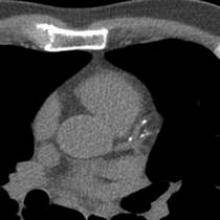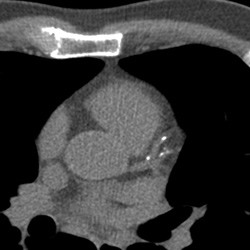User login
Potentially practice-changing new techniques for improving cardiovascular CT imaging quality were hot topics at this years meeting of the Society of Cardiovascular Computed Tomography. Here’s a rundown of techniques that you can expect to see more frequently.
Fractional Flow Reserve CT
One problem with coronary CT angiography (CCTA) has been that it does not define the hemodynamic significance of coronary lesions. Cardiologists have relied on fractional flow reserve (FFR) measured at the time of invasive coronary angiography to determine specifically the hemodynamic significance of coronary artery lesions (lesion-specific ischemia). FFR is defined as the ratio of maximal myocardial flow through a diseased artery to the blood flow in the hypothetical case that this artery is normal. Values less than or equal to 0.80 or 0.75 are considered to be diagnostic of lesion-specific ischemia. Assessment of lesion-specific ischemia improves event-free survival.
CT FFR uses some very sophisticated and complex computational methods which are applied to data from a normal CCTA. This allows cardiologists to quantify the FFR for each lesion seen on CCTA with the data taken from the same image. The result is that they are able to identify which stenoses are causing ischemia and should be treated – all noninvasively.
Dual-Source CT
Calcium and motion artifacts have long been a bane to cardiologists and radiologists. Calcium plaques have been shown to appear larger on CCTA. When calcium plaque volume is overestimated, luminal diameter is underestimated and the percentage of diameter stenosis is overestimated.
Dual-source CT has recently received Food and Drug Administration 510k clearance for cardiac CT studies. Basically the detector switches very quickly between two energies, improving the clarity of image of calcium plaque (reducing artifacts) and increasing accuracy.
Snapshot Freeze
Coronary motion can occur at high and low heart rates, resulting in both false positives and false negatives. SnapShot Freeze was developed to help significantly reduce coronary motion. By precisely detecting vessel motion and velocity, the SnapShot Freeze algorithm can determine actual vessel position and corrects the effects of motion during cardiac CT exams. The reduction of coronary motion artifacts increases interpretability and improves accuracy.
CT Perfusion
The assessment of the luminal coronary artery narrowing with CCTA has been a poor predictor of myocardial ischemia and has required additional perfusion imaging to identify patients who might benefit from revascularization.
Several trials have shown that CT perfusion imaging has a high sensitivity and negative predictive value when compared against SPECT. CT perfusion also appears to be an affective technique for noninvasively evaluating patients with abnormal CT scans. Data are expected next year from several multicenter clinical trials.
--By Kerri Wachter (on twitter @knwachter)
Potentially practice-changing new techniques for improving cardiovascular CT imaging quality were hot topics at this years meeting of the Society of Cardiovascular Computed Tomography. Here’s a rundown of techniques that you can expect to see more frequently.
Fractional Flow Reserve CT
One problem with coronary CT angiography (CCTA) has been that it does not define the hemodynamic significance of coronary lesions. Cardiologists have relied on fractional flow reserve (FFR) measured at the time of invasive coronary angiography to determine specifically the hemodynamic significance of coronary artery lesions (lesion-specific ischemia). FFR is defined as the ratio of maximal myocardial flow through a diseased artery to the blood flow in the hypothetical case that this artery is normal. Values less than or equal to 0.80 or 0.75 are considered to be diagnostic of lesion-specific ischemia. Assessment of lesion-specific ischemia improves event-free survival.
CT FFR uses some very sophisticated and complex computational methods which are applied to data from a normal CCTA. This allows cardiologists to quantify the FFR for each lesion seen on CCTA with the data taken from the same image. The result is that they are able to identify which stenoses are causing ischemia and should be treated – all noninvasively.
Dual-Source CT
Calcium and motion artifacts have long been a bane to cardiologists and radiologists. Calcium plaques have been shown to appear larger on CCTA. When calcium plaque volume is overestimated, luminal diameter is underestimated and the percentage of diameter stenosis is overestimated.
Dual-source CT has recently received Food and Drug Administration 510k clearance for cardiac CT studies. Basically the detector switches very quickly between two energies, improving the clarity of image of calcium plaque (reducing artifacts) and increasing accuracy.
Snapshot Freeze
Coronary motion can occur at high and low heart rates, resulting in both false positives and false negatives. SnapShot Freeze was developed to help significantly reduce coronary motion. By precisely detecting vessel motion and velocity, the SnapShot Freeze algorithm can determine actual vessel position and corrects the effects of motion during cardiac CT exams. The reduction of coronary motion artifacts increases interpretability and improves accuracy.
CT Perfusion
The assessment of the luminal coronary artery narrowing with CCTA has been a poor predictor of myocardial ischemia and has required additional perfusion imaging to identify patients who might benefit from revascularization.
Several trials have shown that CT perfusion imaging has a high sensitivity and negative predictive value when compared against SPECT. CT perfusion also appears to be an affective technique for noninvasively evaluating patients with abnormal CT scans. Data are expected next year from several multicenter clinical trials.
--By Kerri Wachter (on twitter @knwachter)
Potentially practice-changing new techniques for improving cardiovascular CT imaging quality were hot topics at this years meeting of the Society of Cardiovascular Computed Tomography. Here’s a rundown of techniques that you can expect to see more frequently.
Fractional Flow Reserve CT
One problem with coronary CT angiography (CCTA) has been that it does not define the hemodynamic significance of coronary lesions. Cardiologists have relied on fractional flow reserve (FFR) measured at the time of invasive coronary angiography to determine specifically the hemodynamic significance of coronary artery lesions (lesion-specific ischemia). FFR is defined as the ratio of maximal myocardial flow through a diseased artery to the blood flow in the hypothetical case that this artery is normal. Values less than or equal to 0.80 or 0.75 are considered to be diagnostic of lesion-specific ischemia. Assessment of lesion-specific ischemia improves event-free survival.
CT FFR uses some very sophisticated and complex computational methods which are applied to data from a normal CCTA. This allows cardiologists to quantify the FFR for each lesion seen on CCTA with the data taken from the same image. The result is that they are able to identify which stenoses are causing ischemia and should be treated – all noninvasively.
Dual-Source CT
Calcium and motion artifacts have long been a bane to cardiologists and radiologists. Calcium plaques have been shown to appear larger on CCTA. When calcium plaque volume is overestimated, luminal diameter is underestimated and the percentage of diameter stenosis is overestimated.
Dual-source CT has recently received Food and Drug Administration 510k clearance for cardiac CT studies. Basically the detector switches very quickly between two energies, improving the clarity of image of calcium plaque (reducing artifacts) and increasing accuracy.
Snapshot Freeze
Coronary motion can occur at high and low heart rates, resulting in both false positives and false negatives. SnapShot Freeze was developed to help significantly reduce coronary motion. By precisely detecting vessel motion and velocity, the SnapShot Freeze algorithm can determine actual vessel position and corrects the effects of motion during cardiac CT exams. The reduction of coronary motion artifacts increases interpretability and improves accuracy.
CT Perfusion
The assessment of the luminal coronary artery narrowing with CCTA has been a poor predictor of myocardial ischemia and has required additional perfusion imaging to identify patients who might benefit from revascularization.
Several trials have shown that CT perfusion imaging has a high sensitivity and negative predictive value when compared against SPECT. CT perfusion also appears to be an affective technique for noninvasively evaluating patients with abnormal CT scans. Data are expected next year from several multicenter clinical trials.
--By Kerri Wachter (on twitter @knwachter)

